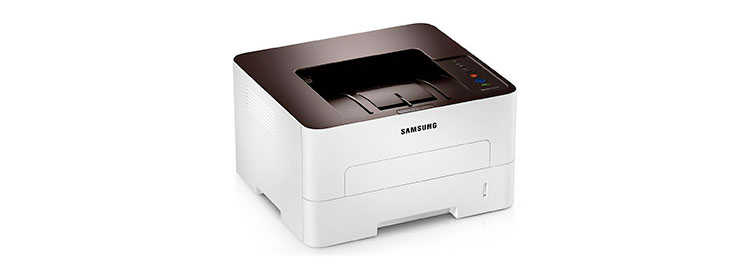One step up in Samsung’s line from the Editors’ Choice Samsung Xpress M2625D$69.99 at Amazon that I recently reviewed, the Samsung Xpress M2825DW ($150 street) delivers essentially the same output quality, paper handling, and speed on our tests. What it primarily adds for the step up in price is Ethernet and Wi-Fi, including Wi-Fi Direct, along with support for mobile printing. As with its lesser sibling, it delivers enough to make it Editors’ Choice, but in this case as a shared printer in a micro office or as a personal printer if you need the network connection or mobile printing.
The mobile printing support lets you print through the cloud and print from Android, iOS, and Windows smartphones and tablets. For printing through the cloud, the printer has to be connected to your network, using either an Ethernet or Wi-Fi connection. For printing from a mobile device, however, you have two choices.
If the printer’s on a network, you can connect through a Wi-Fi access point. Thanks to the printer’s Wi-Fi Direct, however, you can also connect directly from your mobile device to the printer, a trick you can take advantage of even for a personal printer connected to your computer by USB cable.
Basics and Setup
Other than the network and mobile printing support, there’s little difference between the Samsung M2625D and M2825DW. Both printers are the same size at 8.0 by 14.5 by 13.2 inches (HWD), making them small enough to share a desk with easily, and both weigh just 16.4 pounds. They also both offer the same paper handling, with a 250-sheet input tray, a one-sheet manual feed slot, and a duplexer (for automatic two-sided printing). This should be suitable for most personal or micro office use, but if you need more, you’ll have to look elsewhere. Samsung doesn’t offer any paper handling upgrades.
Setting up the M2825DW on a network is absolutely typical for a monochrome laser. For my tests, I connected it using the Ethernet port and installed the drivers on a system running Windows Vista.
Speed and Output Quality
Samsung rates the M2825DW at 29 pages per minute (ppm) compared with 27 ppm for the Samsung M2625D. The differences showed in my tests when printing a text file with little formatting, with the M2825DW coming in at 30.3 ppm, or not quite 2 ppm faster than the M2825DW. However, the two scored essentially identical speeds on our business applications suite (using QualityLogic’s hardware and software for timing), at 9.9 ppm.
As with the Ssamsung M2625D, this counts as a good speed for the price, but not a particularly impressive one. The Editors’ Choice Brother HL-2270DW$149.99 at Sears, for example, came in at 11.7 ppm.
The M2825DW was virtually identical to the Samsung M2625D for output quality in my tests as well. Text was easily good enough for any business needs, with scores falling in the middle of a fairly tight range that includes the vast majority of mono laser printers.
Graphics and photos were both absolutely typical for a mono laser. For graphics output, that translates to being suitable for any internal business need. Depending on how critical an eye you have, however, you may or may not consider it good enough for PowerPoint handouts or the like. For photos, par quality means being able to print recognizable images from photos in Web pages and print photos in general at roughly newspaper-level photo quality.
The Samsung Xpress M2825DW is a strong contender not because of any particularly impressive feature, but because of a constellation of features that fit together well. It’s not quite fast as the Brother HL-2270DW, for example, but it delivers a highly attractive balance of speed, output quality, paper handling, and more. As a shared printer in a micro office, or a personal printer that also makes mobile printing easy, that overall balance makes the Samsung Xpress M2825DW an easy pick for Editors’ Choice.
original article
- Samsung Xpress M2825DW(pcmag.com)







